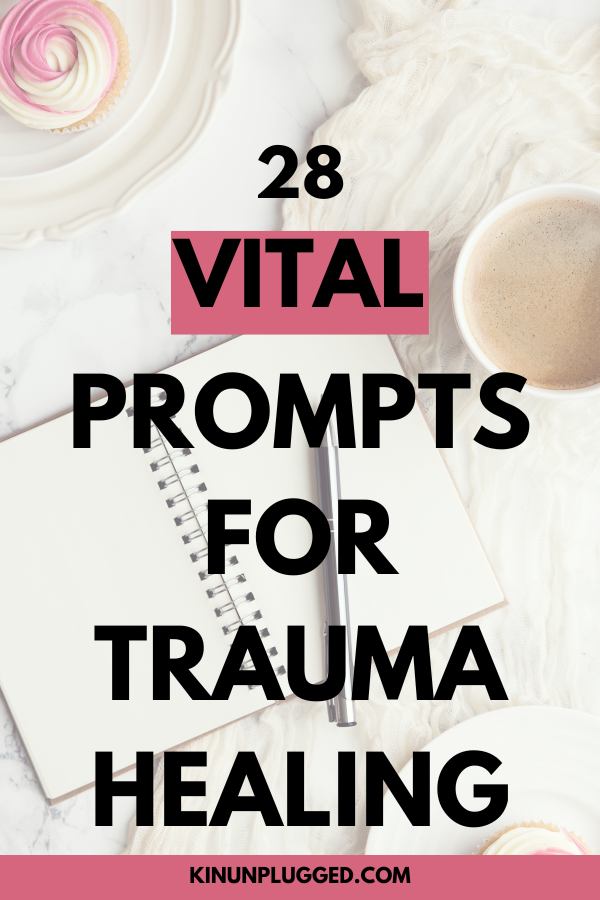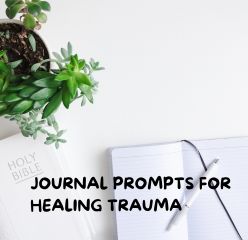Journaling prompts for trauma healing can seem like a tiny step towards that healing. Ask anyone who has been journaling over a long period of time and they will confirm that the activity can transform your life in different ways.
Journaling with the right writing prompts for recovery can be an extremely cathartic way to guide yourself through healing from trauma and can also be used in conjunction with other forms of trauma healing techniques.
RELATED: 9 Clear Childhood trauma symptoms in adults
In this article, we will consider a few useful techniques that people use in efforts to heal from trauma. The focus will be on journaling and how it can help to heal trauma. I’ll give you tips on how to journal for trauma healing. I will then give you some helpful prompts that will help to give you focus when journaling.
How do you release trauma from your body?

There are quite a few practices that you can incorporate into your life in an attempt to release the trauma from your body. They can be used together or on their own.
Here are some helpful ways to try to release trauma from your body:
- Breath work. Breathwork involves intentional control and awareness of breathing patterns. Deep, conscious breathing can help regulate the nervous system, promoting relaxation and reducing the physiological impact of trauma. By focusing on breath, individuals can calm the sympathetic nervous system, easing anxiety and stress associated with traumatic experiences.
- Cognitive processing therapy. CPT is a type of cognitive-behavioral therapy designed to address and reframe negative thought patterns related to traumatic events. By challenging and changing maladaptive thought processes, individuals can alter their perception of the trauma, leading to a reduction in emotional distress.
- Talking. Verbal expression of traumatic experiences is a fundamental aspect of many therapeutic approaches. Talking allows individuals to process and make sense of their emotions and memories. Open communication fosters a sense of validation, support, and connection, reducing the emotional burden associated with trauma.
- Mindfulness. Mindfulness involves being present in the moment without judgment. Mindful practices, such as meditation, can help individuals become more aware of their thoughts and feelings. By cultivating mindfulness, individuals can create distance from distressing thoughts, reduce reactivity, and build resilience in the face of trauma.
- Daily stretches. Physical tension is often held in the body after a traumatic event. Daily stretches and gentle movement can help release muscular tension. Physical activity promotes the release of endorphins, the body’s natural stress relievers, and helps individuals reconnect with their bodies in a positive way.
- EMDR therapy. EMDR is a therapeutic approach that involves guided eye movements to process traumatic memories. It aims to reprocess distressing memories, reducing their emotional charge and helping individuals integrate these memories in a less distressing way.
- Journaling. Specifically using journaling prompts for trauma healing to write about traumatic experiences can be a form of catharsis and self-reflection. Journaling allows individuals to externalize their thoughts and feelings, gain insights, and track their progress in coping with trauma.
These practices offer a holistic approach to trauma recovery as they address both the psychological and physiological aspects of the impact of trauma on the body and the mind. Each practice provides a special and useful way for individuals to explore and figure out what works best for their individual trauma healing journey.
Let’s go into even more detail about how journaling helps with dealing with trauma.
How journaling helps with trauma

- Helps to increase your own capacity for empathy
Engaging in journaling, particularly with targeted prompts for trauma healing, allows individuals to delve into their emotions and thoughts linked to traumatic experiences. This introspective process cultivates self-awareness, fostering a deeper understanding of one’s emotional landscape.
The use of journaling prompts for trauma healing amplifies self-empathy, leading to an enhanced understanding and empathy not only for oneself but also for others who have undergone similar experiences.
- Improves your ability to express your trauma to others
Journaling, guided by prompts tailored for trauma healing, provides a secure space for individuals to express the intricacies of their traumatic experiences. This controlled exploration enables the thorough examination of complex emotions and memories.
By practicing the articulation of trauma using specific prompts, individuals refine their communication skills. This refined ability to express their experiences becomes especially valuable when sharing their story with others, facilitated by the structured nature of journaling prompts for trauma healing.
- Validates the significance of your traumatic experience
The act of recording traumatic experiences in a journal, particularly with prompts for trauma healing, serves as a validating process, recognizing the impact and importance of these events.
Journaling with prompts designed for trauma healing allows individuals to affirm the significance of their experiences. This validation is crucial in countering tendencies to downplay or dismiss the trauma, providing a necessary acknowledgment through the guided exploration of dedicated prompts.
- Helps in emotional self-regulation
Utilizing journaling prompts for trauma healing offers a structured outlet for processing intense emotions associated with trauma. Writing, guided by prompts, externalizes feelings and empowers individuals to regain control over their emotional responses.
Through the use of prompts, individuals can engage in emotional self-regulation during journaling. This structured process aids in managing overwhelming emotions, reducing anxiety and fostering a sense of calm and clarity in the healing journey.
How to journal for healing trauma
- Find or create an appropriate journaling space
Begin by choosing a comfortable and safe space for your journaling practice. This might be a cozy corner in your home or a quiet outdoor spot. Creating a dedicated space can help you feel secure and more open to the process of self-reflection.
- Allocate a specific convenient time
Even if it’s only 5 minutes. Set aside a specific time each day or week for your journaling practice. Consistency is key in building a routine that supports healing. Whether it’s in the morning, before bed or during lunch breaks, having a designated time helps integrate journaling into your self-care routine.
- Push away worries about spelling and grammar
When journaling for trauma healing, the focus is on expressing your emotions and thoughts, not perfection. Don’t let concerns about spelling or grammar hinder your writing. The goal is to release your feelings onto the paper without judgment.
- Periodically go back and reflect on your journal entries
Revisit your previous entries to observe patterns, progress, or changes in your emotions and perspectives. This reflection can provide valuable insights into your healing journey, offering a sense of continuity and growth over time.
- Sometimes, analyze your thoughts as you write them out
While the emphasis is on free expression, occasionally pause to analyze specific thoughts or emotions as you write. This self-reflection can deepen your understanding of the underlying issues and contribute to the therapeutic nature of the journaling process.
- Expect some level of distress from recalling your trauma
Recognize that delving into past traumas might bring up difficult emotions. It’s essential to approach this with self-compassion and an understanding that healing is a gradual process. If the distress becomes overwhelming, consider seeking support from a therapist or counselor.
Incorporating journaling prompts for trauma healing
To enhance your journaling experience, consider using specific prompts tailored for trauma healing. These prompts can guide your reflections, helping you explore emotions and memories in a structured and supportive way.
Journaling is a personal journey, and these prompts serve as tools to assist you in your healing process.
21 Journal prompts for processing trauma triggers

1.Describe a recent situation that triggered intense emotions or memories related to your trauma. What specific elements or aspects triggered this response?
2. Explore the emotions that arose during the triggering event. What specific feelings did you experience, and how would you describe them?
3. Reflect on any physical sensations you felt during the triggering moment. Did you notice tension, changes in heartbeat, or other bodily reactions?
4. Examine the thoughts that crossed your mind when you encountered the trigger. Were there automatic negative thoughts or self-criticisms?
5. List the coping mechanisms you employed during or after the triggering event. Did you find any strategies helpful, and are there alternative methods you could explore?
6. Identify places or activities that make you feel safe and grounded. How can you incorporate these safe spaces into your life to manage triggers more effectively?
- Consider the support system around you. Reflect on whether you reached out to anyone during the trigger incident and how that interaction impacted your experience.
- Practice self-compassion by writing a letter to yourself, acknowledging the difficulty of facing triggers and expressing kindness towards your own emotional responses.
- Explore whether there are boundaries you need to set in your life to minimize exposure to certain triggers. How can you communicate and establish these boundaries effectively?
- Think about how you can prepare yourself for potential triggers in the future. What strategies or tools can you implement to navigate similar situations more comfortably?
- Visualize a symbol or image representing healing. How does this image make you feel, and can it serve as a mental anchor during trigger moments?
- Reflect on how media (movies, TV shows, etc.) may trigger your trauma. Are there specific themes or narratives that you find particularly challenging?
- Consider how others might perceive or interpret the triggering situation. Does adopting a different perspective offer new insights or coping strategies?
- Explore any spiritual or religious practices that help you cope with trauma triggers. How do these practices contribute to your sense of resilience?
- Reflect on whether trauma triggers have generational roots in your family. Are there patterns that have been passed down, and how do you navigate breaking these cycles?
- Consider how confronting triggers has contributed to your personal growth. In what ways have you become more resilient or self-aware?
- Envision a symbolic act of releasing triggers. How can rituals of letting go contribute to your healing journey?
- Use a creative outlet (art, writing, music) to express your experience with triggers. How does creative expression contribute to your healing journey?
- Reflect on how trauma triggers impact your ability to trust others. Are there steps you can take to rebuild trust in relationships?
- Identify moments of gratitude during or after trigger incidents. What positive aspects or lessons can you draw from these challenging experiences?
- Reflect on the concept of forgiveness, both for others and yourself, in the context of trigger incidents. How does cultivating self-compassion contribute to your healing process?
28 Vital journaling prompts for trauma healing

- Identify moments where you exhibited strength during difficult times. How can you draw on these experiences for ongoing healing?
- Acknowledge the individuals who have supported you on your healing path. How have their actions impacted your recovery?
- Evaluate your current coping mechanisms. Are there new strategies you want to explore or refine?
- List three things you are grateful for today. How can incorporating gratitude into your routine enhance your well-being?
- Reflect on the concept of forgiveness in your healing journey. How has forgiveness, both for others and yourself, played a role?
- Recall instances where you felt empowered during your healing process. How can you cultivate more moments of empowerment?
- Connect with your inner child. What activities or practices bring joy and comfort to your inner child?
- Examine your boundaries in various aspects of life. Are there areas where you need to establish or reinforce boundaries for your well-being?
- Explore specific triggers and how they manifest in your life. What insights can you gain from understanding these triggers?
- Identify instances of growth within setbacks. How have challenges contributed to your personal development?
- Reflect on your dreams and aspirations. How do they align with your journey of healing, and what steps can you take to pursue them?
- Explore your connection with nature during moments of healing. How can spending time in nature contribute to your overall well-being?
- Create affirmations that resonate with your healing goals. How can positive affirmations influence your mindset?
- Focus on bodily sensations related to trauma. How can cultivating body awareness contribute to your healing process?
- Develop rituals or symbolic acts for closure. How can these rituals help you let go of aspects of the past?
- Close your eyes and visualize a peaceful place. How does this imagery contribute to a sense of calm and safety?
- Express your emotions through art. How does the creative process provide an outlet for healing?
- Explore the integration of healthy habits into your routine. How can physical well-being support emotional healing?
- Tap into your inner wisdom. What intuitive insights or guidance do you receive about your healing journey?
- Reflect on cultural or spiritual practices that resonate with your healing journey. How can cultural or spiritual connections contribute to your well-being?
- Write a letter to your younger self. What advice and comfort would you offer to the younger version of you?
- Engage your senses in a specific activity. How do sensory experiences contribute to your present moment and overall healing?
- Identify lessons learned from your experiences. How can integrating these lessons contribute to ongoing growth and healing?
- Examine the role of boundaries in your relationships. How can clear boundaries foster healthier connections?
- Visualize your future self healed and thriving. What steps can you take today to move closer to that vision?
- Use metaphors to describe your healing process. What images or symbols resonate with your journey?
- Reflect on your healing journey so far. What progress have you made, and what challenges remain?
- Set intentions for your healing journey. What specific intentions will guide your actions and mindset moving forward?
Are you using journaling prompts for trauma healing? What kinds of changes are the prompts making to your healing journey?





